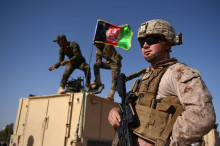A decade ago, New York Times reporter Dexter Filkens wrote, “The Forever War.” The book was a best-seller.
Filkens explained why we were mired in the Mideast. A few years later, President Obama announced America’s “Rebalance to the Asia-Pacific.”
Most assumed this was the spark that would help America disengage from the messy politics of the Mideast.
We are still there – in force. Michael O’Hanlon explains why in his piece, “Resigned to Endless War.” Here’s how he begins:
Tell me how this ends.” So said then-Maj. Gen. David Petraeus to the journalist Rick Atkinson soon after the U.S. invasion of Iraq in 2003. As far as we can see today, the answer to Gen. Petraeus’s prescient rhetorical question appears to be that it doesn’t.
What many strategists predicted would be a generation-long struggle against Islamic extremism and sectarianism in the Middle East is now well into its second generation. It has been almost 40 years since the Iranian revolution and the Soviet invasion of Afghanistan; 35 years since the bombing of the U.S. embassy and Marine barracks in Lebanon; 30 years since the formation of al Qaeda. It has been almost two decades since President George W. Bush, after the attacks of 9/11, told Congress and the nation that “Americans should not expect one battle but a lengthy campaign unlike any other we have ever seen.” The “forever war,” as the journalist Dexter Filkins called it in his 2008 book of that title, is living up to its name.
To wage these wars, there are currently some 15,000 U.S. troops stationed in Afghanistan, 10,000 in Qatar, 5,000 in Iraq, 4,000 in Bahrain, 2,000 each in Syria and Kuwait, and more than 1,500 each in Djibouti and Turkey. Add to this some 10,000 sailors and Marines afloat in the region, as well as Coast Guard personnel and civilians. All told, there are more than 90,000 Americans working for U.S. Central Command, according to Centcom commander Gen. Joseph Votel. These “overseas contingency operations” cost more than $30 billion a year, on top of the $600 billion-plus core defense budget. It’s a huge, expensive effort, and there’s no end in sight.
But maybe all of this is OK. It seems that Americans have effectively reached a consensus that the status quo represents the least bad option available. To put it differently, maybe we’ve taken a page from Israel’s handbook: We no longer expect to solve problems in the broader Middle East, only to manage them, at least for the foreseeable future. As a practical matter, that means relying today not primarily on U.S. ground combat troops but on our special forces, drones, aircraft, trainers, intelligence operatives and standoff forces.


